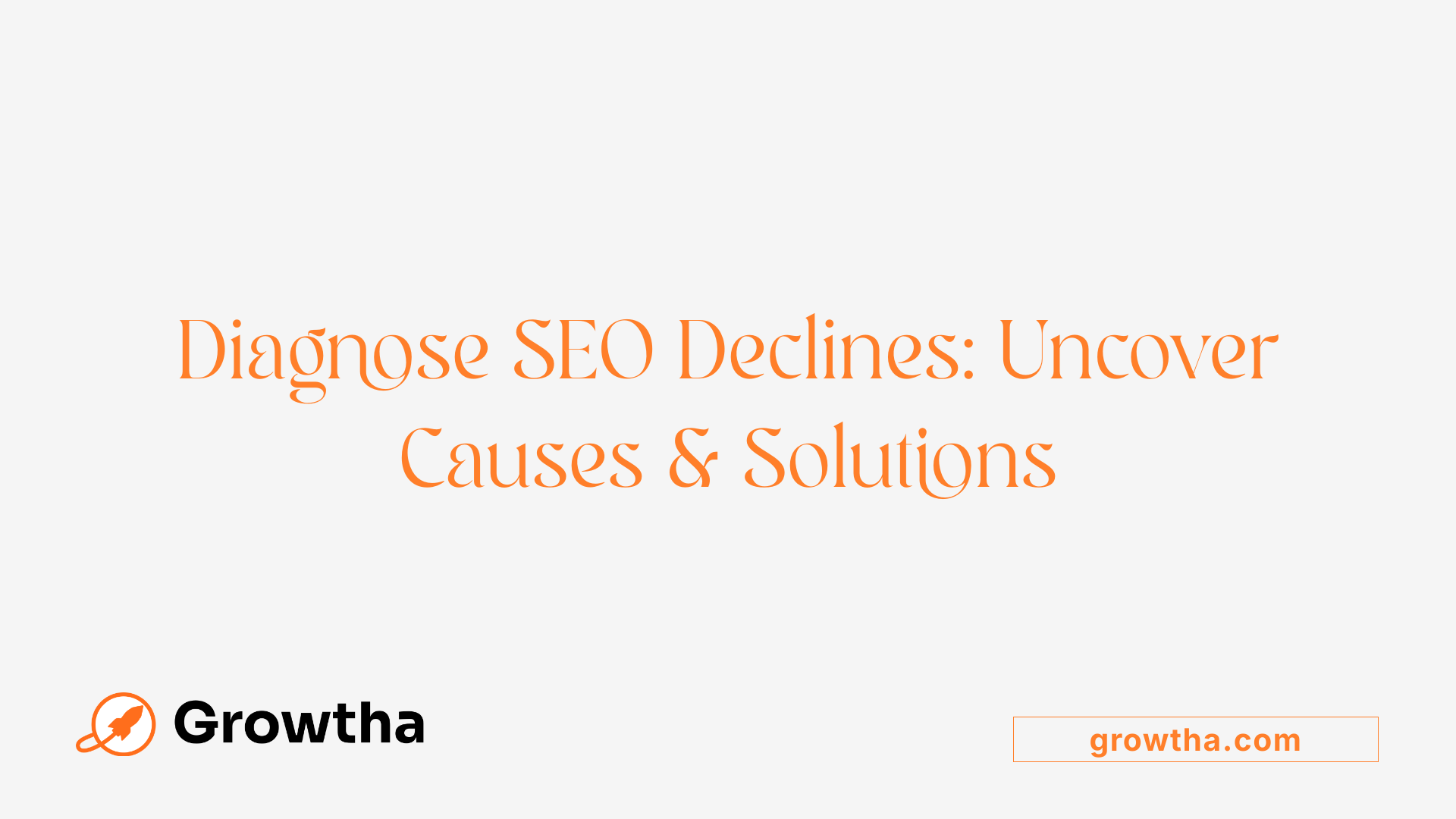How to Recover Lost SEO Rankings in Healthcare
Reviving Your Healthcare Website’s Search Presence: Strategies and Best Practices


How to Recover Lost SEO Rankings in Healthcare
Understanding SEO Declines in Healthcare: Causes and Solutions
Losing SEO rankings can significantly impact healthcare providers, affecting patient access and reputation. Recognizing the common causes of ranking drops—from algorithm updates to technical faults—is crucial for effective recovery. This comprehensive guide explores diagnostics, remedial strategies, and ongoing SEO health maintenance tailored specifically to the healthcare sector.
Identifying the Root Causes of SEO Declines in Healthcare

Why has my Google ranking dropped?
A decrease in Google rankings can stem from multiple factors. The most common causes include algorithm updates, technical issues on your website, content-related problems, manual penalties, and changes in your link profile.
Analyzing your website's performance with tools like Google Search Console can help pinpoint the exact time and pages affected. Technical issues such as errors during site migration, duplicate content, broken links, or poor URL structures often cause rankings to decline. On the content side, outdated, low-quality, or thin content can make your site less trustworthy in Google's eyes.
Manual penalties are another common reason, usually due to violations like spammy backlinks, keyword stuffing, or non-compliance with Google’s guidelines. Lastly, losing valuable backlinks or an unfavorable change in your link profile can reduce domain authority and hurt your rankings.
To address these issues, start with a detailed audit of your site. Repair technical flaws, update and enrich content, and review your backlink profile. Consistent monitoring facilitates swift action to correct problems and safeguard against future drops.
Why did SEO ranking drop?
Sudden ranking drops are often alarming, but they can happen even if your SEO efforts are sound. The reasons include recent algorithm updates that change ranking criteria, shifts in the Search Engine Results Pages (SERPs), increased competition, or modifications to your website.
Sometimes, external factors like seasonal variations or user behavior shifts can also impact visibility. Staying informed about Google's updates and industry trends helps you adapt your strategies promptly.
How to diagnose reasons for SEO ranking declines?
Diagnosing the root cause involves multiple investigative steps. First, examine Google Search Console for manual actions, crawl errors, or indexing issues. Look for significant dips in organic traffic and variations in impression and click-through rates.
Compare your keyword rankings over time and assess if shifts align with recent algorithm updates. Conduct a comprehensive technical SEO audit to identify slow-loading pages, duplicate content, or blocked crawler access. Regular backlink profile reviews reveal losing high-quality links or exposure to spammy, toxic backlinks.
Monitoring competitor activity can provide insights into new strategies or content updates affecting rankings. Additionally, pay attention to any changes in SERP features, such as featured snippets or local packs, which could redirect traffic.
Understanding these layers enables targeted interventions, from technical fixes to content improvements, thereby enhancing your site’s search performance.
Technical SEO and Content Strategies for Recovery

How to diagnose reasons for SEO ranking declines?
Diagnosing a drop in SEO rankings involves a step-by-step analysis of various aspects of your website and SEO practices. Start by examining Google Search Console for manual penalties, crawl errors, and indexing issues. Look for significant decreases in impressions, clicks, or CTR (click-through rate) over time.
Next, perform a comprehensive site audit to identify technical faults. Tools like Google PageSpeed Insights can reveal slow-loading pages, while crawling tools help detect broken links and duplicate content issues.
Monitor your backlinks profile as well. Loss of high-quality links or an influx of spammy backlinks can negatively impact rankings.
It’s also crucial to stay updated on recent algorithm changes from Google, which could influence your site's performance. Comparing your site’s performance against competitors can help identify potential content gaps or new strategies they are using.
Lastly, consider external factors such as seasonal trends or reputation issues, which can also affect SEO visibility.
What site audits are necessary for recovery?
A comprehensive site audit should encompass a review of technical elements, content quality, and backlinks. Use dedicated SEO tools like SEOmator or Semrush for deep insights.
Technical focus areas include fixing crawl errors, optimizing site speed, ensuring mobile responsiveness, and resolving structural issues like bad redirects or canonical problems.
Content analysis involves reviewing the relevance, originality, and keyword usage of your pages. Check for duplicate or thin content, and update or expand these areas.
Backlink audits are essential to identify and disavow spammy or toxic links, which could harm your domain authority.
How fixing crawl errors and improving page load speeds aid recovery?
Crawl errors prevent search engines from properly indexing your site’s content. Fixing these issues ensures your pages are discoverable and ranked correctly.
Page load speed directly influences user experience and search rankings. Slow sites lead to higher bounce rates and lower rankings. Improving load times by optimizing images, leveraging browser caching, and minimizing code can significantly enhance SEO performance.
Why is mobile optimization crucial?
Google primarily uses mobile-first indexing. Making your site mobile-friendly ensures compatibility across devices, improves user experience, and helps maintain or improve rankings.
Mobile optimization includes responsive design, easy-to-read fonts, accessible buttons, and fast loading times on smartphones and tablets.
How do structured data and schema markup influence your rankings?
Implementing structured data via schema markup helps search engines understand your content better. This can lead to enhanced listings, improved visibility, and higher CTRs.
Schema types relevant to healthcare include reviews, medical conditions, procedures, and doctor info. Proper markup ensures your site can benefit from rich snippets and other SERP features.
What is the importance of removing duplicate content?
Duplicate content can dilute your page authority and confuse search engines. Removing or consolidating duplicate content helps ensure that your most valuable pages rank higher.
Use canonical tags and 301 redirects to manage duplicate pages, and regularly audit your content to maintain unique, high-quality offerings.
How can keyword optimization and content enhancement aid recovery?
Targeted keyword optimization involves researching relevant medical and healthcare keywords, incorporating them naturally into your content, titles, and meta descriptions.
Enhancing content quality by providing accurate, well-reviewed, and comprehensive information aligns with E-A-T principles, increasing user engagement and search rankings.
Update outdated articles, add new data or insights, and ensure your content matches current search intent.
| Still to Cover | Topics | How They Impact SEO Recovery |
|---|---|---|
| Site audits | Technical, Content & Backlink | Foundation for fixing issues and identifying opportunities |
| Fixing crawl errors | Technical SEO | Ensures search engines can index your pages properly |
| Improving page load speeds | Performance | Boosts user experience and rankings |
| Mobile optimization | User Experience | Maintains compliance with mobile-first indexing |
| Structured data & schema | Rich Snippets | Enhances visibility with rich results |
| Duplicate content removal | Content Quality | Ensures authority and relevance |
| Keyword optimization | Content Strategy | Aligns content with user queries |
| Content quality | Authority & Trust | Builds credibility and appeal |
Staying proactive with ongoing site audits, monitoring algorithm updates, and refining your strategy based on data insights are essential for maintaining and improving your rankings post-recovery. Partnering with healthcare digital marketing experts can further streamline these efforts, ensuring compliance with stricter Google guidelines like YMYL and HIPAA, and boosting overall site authority.
Local and Off-Page SEO Enhancements

How to recover from an SEO penalty?
Recovering from an SEO penalty involves a systematic process of identifying the penalty type, whether manual or algorithmic. Begin by inspecting Google Search Console for manual action notices and analyzing your backlink profile for toxic links using tools like SEOmator’s Free Backlink Checker.
If a manual penalty is detected, remove or disavow harmful backlinks, and submit a reconsideration request after fixing any violations such as low-quality or manipulative content. For algorithmic penalties, commonly caused by updates like Panda or Penguin, focus on improving the quality and relevance of your content. Removing thin, duplicate, or low-value content, optimizing for E-E-A-T (Experience, Expertise, Authority, Trustworthiness), and strengthening your backlink profile with high-quality links are essential.
Conduct comprehensive site audits to identify technical SEO issues like slow site speed, poor mobile responsiveness, or schema errors. Fix these issues promptly to signal to Google that your site complies with best practices. Regularly monitor your site’s performance and adhere strictly to Google’s guidelines.
Recovery timelines vary depending on the penalty’s severity but generally range from a few weeks to several months. Consistent effort, along with ongoing SEO best practices—such as content enhancement, backlink rebuilding, and technical fixes—is crucial for a successful recovery.
How to boost local visibility and optimize Google Business Profile?
Enhancing local presence begins with claiming and fully optimizing your Google Business Profile (GBP). Fill out every section with accurate, detailed information, including your business name, address, phone number (NAP), hours, and services. Upload high-quality photos showing your facilities, staff, and services to attract more local users.
Maintaining consistent NAP information across all online platforms improves your local SEO signals. Encourage satisfied patients to leave positive reviews on your GBP and other review sites; active review management enhances your reputation and local rankings.
Update your profile regularly with posts about new services, special offers, or health tips relevant to your local audience. Creating localized content on your website, such as region-specific service pages and utilizing local keywords, helps attract nearby patients.
Building local citations on directories like Healthgrades, Zocdoc, Yelp, and WebMD is vital. Ensure your listings are up-to-date and consistent, boosting your visibility in local searches.
How to rebuild or improve backlinks for healthcare SEO recovery?
Backlink health is a cornerstone of strong SEO. Begin with a backlink audit using tools like SEOmator’s Free Backlink Checker to identify low-quality or spammy links that could harm your site’s authority.
Disavow toxic backlinks to prevent algorithmic penalties. Then, focus on acquiring new, high-quality backlinks through authoritative guest posting on reputable healthcare websites, creating shareable content such as infographics and expert articles, and engaging in digital PR efforts.
Establish relationships with relevant healthcare webmasters and influencers to facilitate natural link acquisitions. Consistent outreach, combined with the production of credible, valuable content, will boost your domain authority and support your rankings.
Implementing these off-page strategies—along with ongoing technical SEO, content updates, and local SEO optimization—creates a solid foundation for recovering and sustaining high rankings in search engine results pages.
Leveraging Social Media and Content Marketing for SEO Enhancement

How to recover from an SEO penalty?
Recovering from an SEO penalty involves a thorough diagnosis to understand whether the penalty is manual or algorithmic. Begin by checking Google Search Console for manual action notifications and analyzing your backlink profile for spammy or manipulative links. If a manual penalty is identified, disavow harmful backlinks and submit a reconsideration request to Google after fixing violations like hidden text or cloaking.
For algorithmic penalties, such as those caused by Panda or Penguin updates, focus on improving your site’s content quality. Remove thin, low-value, or duplicate content and strengthen your site’s authority by acquiring reputable backlinks. Technical SEO fixes—including optimizing site speed, ensuring mobile-friendliness, and correcting schema markup errors—are also critical.
A comprehensive site audit can reveal hidden issues impacting your rankings. Conduct regular monitoring using tools like Google Search Console and analytics platforms. Recovery timelines vary from a few weeks to several months; patience and consistent adherence to Google's guidelines are essential.
What content strategies can enhance healthcare SEO?
Effective healthcare SEO relies heavily on content that is relevant, trustworthy, and aligns with patient needs. Creating blog content that directly answers common patient questions builds authority and improves search visibility.
Developing high-quality visual content such as infographics, videos, and patient success stories also enhances engagement. These materials should be easy to understand, medically accurate, and shareable across multiple channels.
A multichannel content strategy—including social media, email newsletters, and healthcare portals—broadens reach and influences search rankings. Incorporate keywords thoughtfully into all content, emphasizing terms your patients are searching for.
Regularly updating your website with new articles, case studies, and testimonials helps maintain relevance. Engaging content not only boosts your rankings but also fosters trust, authority, and a positive reputation among your community.
Leveraging social media to boost healthcare SEO
Social media engagement amplifies your content’s reach and drives traffic to your website, indirectly influencing your SEO efforts. Active social channels expand patient engagement, encourage sharing, and increase brand recognition.
Promote your blog posts and videos through platforms like Facebook, Instagram, and LinkedIn to reach diverse audiences. Engaging with followers by responding to comments and reviews helps build community trust.
Consistently sharing educational content, such as health tips, FAQs, and patient testimonials, enhances your credibility. Social signals—likes, shares, and mentions—can also positively impact your search rankings.
Building credibility through high-quality content and reputation management
Consistently producing accurate, well-reviewed, and authoritative content establishes your healthcare provider’s reputation. Incorporate elements like patient reviews, expert interviews, and evidence-based information.
Address patient concerns openly via FAQs, blog articles, and multimedia content. Managing your online reputation, including responding to reviews and updating your profiles on healthcare directories, is vital.
Utilize multichannel marketing to reinforce your brand trustworthiness and reach new patients.
| Strategy | Description | Best Practices |
|---|---|---|
| Content creation | Producing informative and trustworthy healthcare content | Focus on accuracy, relevance, and keyword optimization |
| Social media engagement | Leveraging platforms to share and promote content | Respond promptly, share diverse content formats |
| Technical SEO improvements | Fixing site and page issues impacting rankings | Improve speed, mobile-friendliness, and structured data |
| Backlink and reputation building | Enhancing authority through backlinks and reviews | Guest posting, patient testimonials, and directory listings |
| Monitoring and analysis | Tracking site performance and ranking changes | Use tools like Google Search Console, Ahrefs, SEMrush |
Mastering a combination of these strategies ensures continual improvement in search rankings, increases visibility, and builds lasting trust among patients. Regular audits, staying updated with algorithm changes, and maintaining a patient-centric content approach are essential.
This ongoing commitment to content quality, technical excellence, and active engagement will position healthcare providers for success in a competitive digital landscape.
Continuous Monitoring and Future-Proofing Strategies

How to find SEO rankings?
To find SEO rankings, start with live rank checkers that allow you to enter your target keywords and domain to view your current positions on search engines like Google. These tools provide real-time insights into how well your website performs for specific keywords. Tools such as Keyword Tool can complement this by generating relevant long-tail keywords based on Google Autocomplete suggestions, supporting multiple languages and regional variations for localized SEO strategies.
Rank checkers reveal where your site stands, but understanding what users are searching for requires keyword research tools. Combining these resources offers a comprehensive view, enabling you to fine-tune your SEO efforts and monitor shifts in rankings effectively.
What measures can maintain SEO health in healthcare?
Maintaining healthy SEO in the healthcare sector involves meticulous, ongoing practices. Regular website audits using tools like Google Search Console or SEOmator can identify issues such as crawl errors, slow page speeds, duplicate content, and broken links. Addressing these technical aspects ensures that your site remains accessible and user-friendly.
Keeping content fresh and authoritative is equally important. Regular updates, including adding new blog posts that answer common patient questions, help maintain relevance. Diversification of traffic sources—through social media, local directories, and paid campaigns—reduces dependence on organic search alone, providing stability against algorithm fluctuations.
Monitoring the latest algorithm changes with tools like SEMrush or Serpstat allows you to adjust strategies promptly. Building a robust backlink profile by earning mentions through guest blogging or digital PR enhances domain authority. Ensuring your website is mobile-friendly,_SECURE with HTTPS, and structured data optimized ensures better ranking performance and compliance.
How can healthcare providers implement future-proof SEO strategies?
Healthcare providers must foster a proactive approach by yearly SEO audits to assess technical health and content quality. Keeping abreast of algorithm updates ensures strategies remain aligned. Content should continually be refined—improving clarity, accuracy, and relevance—and optimized for evolving keywords and user search intent.
Building a diversified traffic portfolio reduces vulnerability—by leveraging local SEO, social media, email marketing, and paid outreach. Ensuring compliance with healthcare-related guidelines like HIPAA, and adherence to Google’s E-E-A-T principles (Experience, Expertise, Authority, Trustworthiness) is vital.
Additionally, engaging with patients via reviews and testimonials helps enhance reputation and local SEO visibility. Using analytics to track performance and health metrics enables timely intervention and continuous improvement, securing long-term search ranking stability.
| Aspect | Tools/Methods | Purpose | Additional Details |
|---|---|---|---|
| Rank Tracking | Google Search Console, Keyword Tool | Monitor search positions | Localized and language-specific insights |
| Technical Audits | SEOmator, PageSpeed Insights | Identify site health issues | Speed, crawl errors, duplicate content |
| Content Optimization | Manual updates, SEO audits | Enhance relevance and authority | Answer patient questions, keyword incorporation |
| Backlink Profile | SEMrush, Ahrefs | Build authority | Disavow toxic links, guest blogging |
| Traffic Diversification | Social media, local listings | Reduce reliance on organic search | Engage users across multiple channels |
| Compliance & Relevance | HIPAA, Google guidelines | Ensure legal and algorithm compliance | Maintain trust and ranking |
In summary, healthcare providers should adopt a holistic, dynamic, and compliant SEO approach. Continuous monitoring, adapting to changes, and diversifying efforts are essential for maintaining and future-proofing search engine rankings, ultimately enhancing visibility and patient engagement.
The Role of Compliance and E-A-T in Healthcare SEO Recovery
Why has my Google ranking dropped?
A decline in Google rankings can stem from several factors, such as algorithm updates, technical issues, or content deficiencies. To pinpoint the cause, it’s crucial to analyze your website’s performance history using tools like Google Search Console. This helps identify when the ranking drop began and which pages or keywords are affected.
Common technical reasons include errors during website migration, duplicate content issues, broken links, or an inefficient URL structure. Content-related problems often involve outdated, low-quality, or thin material that fails to meet user expectations.
Furthermore, manual penalties due to violation of Google’s guidelines or loss of high-quality backlinks can severely hurt your ranking.
To facilitate recovery, you should conduct a comprehensive website audit, correct technical and content issues, ensure compliance with Google’s evolving policies, and stay vigilant for future algorithm changes.
Strategic and Continuous SEO Optimization for Healthcare Success
Recovering lost SEO rankings in healthcare requires a multifaceted approach, combining technical fixes, content improvements, backlink quality enhancement, and ongoing monitoring. By understanding the root causes—be it algorithm updates, penalties, or technical glitches—and applying tailored strategies, healthcare providers can regain visibility and attract more patients. Regular audits, staying updated with Google's guidelines, and leveraging local and off-page SEO tactics are fundamental to future-proofing your healthcare website’s search presence. Commitment to creating trustworthy, authoritative content and maintaining technical health will ensure sustained SEO performance and healthcare sector success.
References
- How to Recover from a Google Website Ranking Drop - Blog
- How to Recover Your SEO Rankings in 9 Steps - SEOmator
- Google Ranking Dropped Dramatically? How To Restore Positions
- Healthcare SEO guide: Strategies and tactics for medical providers
- Healthcare SEO: How to Improve Rankings + Costs Involved
- Google Rankings Drop? How To Diagnose & Fix Ranking Issues
- Recovering Lost Organic Traffic: How to Fix and Regain Rankings
- SEO for Doctors: How to Rank Your Medical Practice on Google
- Five Ways to Improve Your Site's Ranking (SEO) | Michigan Tech
- How do I recover SEO rankings for my tech blog after a relaunch?







